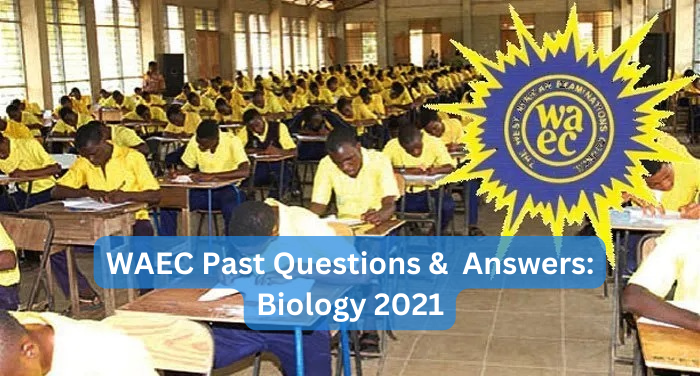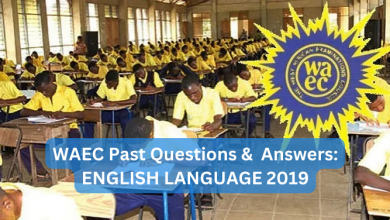WAEC Past Questions & Answers: BIOLOGY 2021

Welcome to our WAEC past question and answer series. In this post, we will be sharing ‘recent’ past questions and their answers for various subjects. Stay tuned enjoy while learning.
1. The gradual cumulative, adaptive and heritable changes in an organism over a long period of time resulting in new species is called…
A adaptation
B survival
C organic evolution
D interspecific competition
2. Which of the following groups of animals do not possess a nervous system?
A Porifera
B Cnidaria
C Platyheminthes
D Nematoda
3. The structural similarities in Paramecium and Euglena are in the…
A shape of locomotory organs
B blunt anterior and pointed posterior
C presence of micro and mega nuclei in both
D presence of anterior and posterior contractile vacuoles
4. Which of the following organisms cannot exist freely on its own?
A Chlamydomonas
B Amoeba
C Paramecium
D Plasmodium
5. Which of the following cell organelles is the site for the production of ATP?
A Lysosome
B Nucleus
C Mitochondrion
D Ribosome
6. An example of osmosis in plants is the
A movement of water through the xylem
B loss of water vapour from the stomata
C translocation of food through the phloem
D absorption of water from the soil by the root
7. The organism that can carry out both autotrophic and heterotrophic modes of nutritions is
A Chlamydomonas
B Eudorina
C Euglena
D Spirogyra
8. The diagram above illustrates a part of the human skeleton. It represents the bones of the
A upper arm
B lower arm
C upper leg
D lower leg
9. trochlea to form a hinge joint?
A I
B II
C III
D IV
10. The diagram above illustrates a part of the human skeleton. The labelled part that provides surface for the attachment of the triceps is
A I
B II
C III
D IV
11. The diagram above illustrates the transverse section of a
A dicotyledonous root
B monocotyledonous root
C dicotyledonous stem
D monocotyledonous stem
12. Which of the following actions does not occur during exhalation in man?
A Thoracic cavity decreases in volume
B Diaphragm flattens
C Ribs move down and in
D Air pressure increases in the thoracic cavity
13. The diagram above is an illustration of the urinary tubule in a mammal. Which of the following substances is found in the part labelled II only?
A Lipid
B Glucose
C Urea
D Uric acid
14. The diagram above is an illustration of the urinary tubule in a mammal. The part which contains lowest concentration of urea is labelled
A I
B II
C III
D IV
15. The diagram above is an illustration of the urinary tubule in a mammal. Which of the following substances is greater in concentration in the part labelled IV when compared to that part labelled I?
A Lipid
B Glucose
C Urea
D Uric acid
16. Deamination of amino acids in the liver produces
A blood sugar
B glycogen
C bile
D urea
17. Which of the following glands also serves as an exocrine gland?
A Ovary
B Pancreas
C Adrenal
D Thyroid
18. When viewing an object that is close to the human eye, the…
A eye lens becomes thin
B ciliary muscles relax
C suspensory lens become taut
D eye lens becomes fat
19. When viewing an object that is close to the human eye, the
A eye lens becomes thin
B ciliary muscles relax
C suspensory lens become taut
D eye lens becomes fat
20. The diagram above is an illustration of the human sperm. The part labelled I is the
A acrosome
B nucleus
C mitochondrion
D tail
21. In the diagram of the human sperm above, the function of the part labelled II is to
A fuse the ovum during fertilisation
B generate the energy for the sperm to swim to the fallopian tube
C help the sperm to swim forward
D dissolve the membrane of the egg during fertilisation
22. Which of the following types of placentation is not common amongst syncarpous pistils?
A Marginal
B Axile
C Parietal
D Free central
23. The complex energy-rich organic matter which living organisms need for life is
A water
B air
C food
D mineral salts
24. Which of the following processes are associated with photosynthesis? I. Energy from sunlight is absorbed II. Carbon dioxide is evolved III. Oxygen is given off IV. Glucose is synthesised
A I and II only
B I, II and IV only
C I, III and IV only
D I, II, III and IV
25. Which of the following function is associated with calcium in plants? Formation of…
A cell wall
B ribosomes
C proteins
D cell membrane
26. The diagram above shows the dentition of an organism. What organism is this?
A rabbit
B cat
C frog
D man
27. The diagrams below show the dentition of an organism. The function of the teeth labelled X is for
A biting and grasping
B chewing and grinding
C tearing and grasping
D chewing and tearing
28. The teeth which are absent in the young of the organism whose dentition is shown above is labelled
A W
B X
C Y
D Z
29. The number of individuals that the environment can support over a long period of time is its
A growth rate
B total capacity
C population capacity
D carrying capacity
30. A good site for secondary succession would be…
A a sand dune
B a bare rock
C a land that has just had forest fire
D a stretch of barren land
31. A population which exceeds its carrying capacity and then collapses is represented graphically by a
A bell-shaped curve
B linear curve
C sigmoid curve
D skewed curve
32. The natural dwelling place of an organism is called its
A ecological niche
B habitat
C population
D environment
33. Which of the following ecological factors will result in food shortage?
A Drought
B Low rate of reproduction
C Emigration
D Topography
34. Soil permeability refers to…
A how easily water passes through the soil
B the proportion of air in the soil
C the proportion of water the soil holds
D how well water rises up the soil
35. Which of the following groups of organisms do not have members that can be called autotrophs?
A Protists
B Mosses
C Chlorophyta
D Fungi
36. Which of the following pyramids gives the most accurate picture of the relationships between at the various trophic levels in a food chain? A pyramid of…
A numbers
B energy
C biomass
D size
37. Which of the following statements is not associated with pyramids of energy?
A Efficiency of energy transfer between trophic levels can be studied
B Comparisons of pyramids for different ecosystems can be made
C More accurate comparisons of trophic levels
D Representation of numbers of organisms at different trophic levels
38. Which of the following materials is not easily biodegradable?
A Polythene bag
B Cotton bag
C Hides and Skin bag
D Paper bag
39. Which of the following pairs of organisms is in a mutualistic relationship?
A Hydra and Sea anemone
B Hermit crab and Sea anemone
C Dodder plant and Cocoa plant
D Mistletoe and Kola-nut
40. The establishment of game reserves and parks is a method of…
A conserving natural resources
B cultivating game
C controlling pollution
D cultural awareness
41. Which of the following practices is not used in conserving water?
A Afforestation
B Damming
C Deforestation
D Reforestation
42. Which of the following resources cannot be renewed?
A Air
B Petroleum
C Food crop
D Soil
43. The type of variation illustrated above is…
A continuous variation
B discontinuous variation
C morphological variation
D environmental variation
44. Which of the following characters is not a morphological variation?
A shape of the nose
B colour of skin
C colour of hair
D tongue rolling
45. An apple plant can produce sexually and asexually and it has 40 chromosomes in its leaf cells. How many chromosomes would be in each gamete and somatic cell?
A 20 chromosomes in the gametes and 10 in the somatic cells
B 40 chromosomes in the gametes and 20 in the somatic cells
C 20 chromosomes in the gametes and 40 in the somatic cells
D 40 chromosomes in the gametes and 40 in the somatic cells
46. Assuming that A is the gene for normal skin colour and is dominant, while a is the gene for albinism and its recessive, what is the likely genotype of the couple which had 50% normal and 50% albino offspring?
A AA, aa
B Aa, aa
C AA, Aa
D Aa, Aa
47. Which of the following statements is true about mutation?
A Phenotype is not involved
B Genotype is not involved
C Artificial induction is not possible
D Genotype is involved
48. One of the structural adaptations of mammals for movement on land is the development of the…
A hollow bones
B pentadactyl limb
C fused thoracic bones
D streamlined body
49. Which of the following is NOT characteristic of social insects?
A All members are identical
B There is division of labour
C The members dwell in the same habitat
D Some members protect the queen
50. The scientist who introduced binomial nomenclature in the classification of organisms was…
A Charles Darwin
B Carolus Linnaeus
C John Ray
D Louis Pasteur
51. Which of the following statements is true about arthropods?
A Prothorax bears only legs
B Mesothorax bears only legs
C Metathorax bears only wings
D Prothorax bears only wings
52. What level of organisation is Spirogyra?
A System
B Organ
C Cell
D Tissue
53. The streaming movement of cytoplasm within the Paramecium is known as…
A Transpiration
B Digestion
C Cyclosis
D Osmosis
54. Which of the following organelles is found only in plant cells?
A Mitochondria
B Ribosomes
C Lysosomes
D Plastids
55. Active transport differs from diffusion in that active transport…
A is a very fast process
B allows the movement of substances against concentration gradient
C takes place in both light and dark reaction of photosynthesis
D occurs in both plant and animal tissues
56. The diagrams above are illustrations of an experimental set-up to demonstrate a type of tropic response in plants. The type of response demonstrated is
A phototropism
B geotropism
C hydrotropism
D thigmotropism
57. A seedling was made to stand in a solution of red ink for three hours and a transverse section of the stem was examined under the microscope. The process being investigated was…
A the importance of micro elements to plants
B ascent of water through the xylem
C diffusion of coloured substances
D distribution of food in plants
58. The source of energy required by plants during food production is…
A Photosynthesis
B Chlorophyll
C Sunlight
D Microorganisms
59. One major difference between plant and animals nutrition is the ability of plants to synthesise…
A Food for plants and animals
B Water for plants
C Water for animals
D Food for plants only
60. By what process is starch converted into maltose?
A Hydrolysis
B Condensation
C Translocation
D Photosynthesis
Answers To Questions
- C
- A
- B
- D
- C
- D
- C
- B
- B
- C
- C
- B
- C
- C
- C
- D
- A
- D
- D
- A
- C
- A
- C
- C
- A
- D
- D
- D
- C
- C
- A
- B
- A
- A
- D
- B
- B
- A
- B
- A
- C
- B
- B
- D
- C
- C
- D
- B
- A
- B
- A
- C
- C
- D
- B
- C
- C
- C
- A
- A





